Kingston WTW Microfiltration Project (2017)
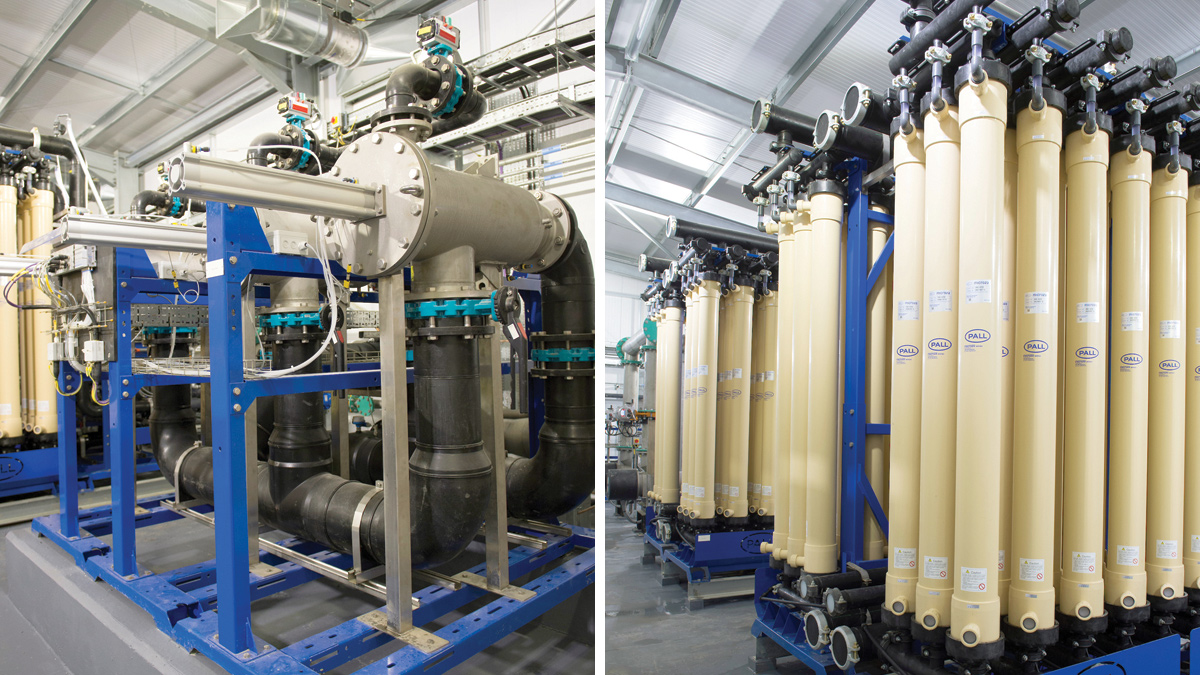
(left) Pre MF strainers and (right) the MF Membrane racks: Courtesy of South East Water/Ady Kerry
Kingston Water Treatment Works (WTW) is located within a 10 minute drive from Canterbury town centre and the train station. The treatment works is located within the Kent Downs Area of Outstanding Natural Beauty (AONB) and is surrounded on three sides by a mature wooded area and on one side by two residential properties. Raw water is abstracted from four boreholes, three of which are on the site whilst the remaining one is located approximately 150m away from the works boundary within the woods. An abstraction licence is in place which stipulates a maximum daily abstraction of 10ML/d.
Background
The abstracted raw water is pumped to the treatment works and is chlorinated onsite before being transmitted via two dedicated rising mains to Canterbury and one to Hastingleigh before for distribution to customers in this area.
With the raw water sourced from the surrounding chalk aquifer the works is susceptible to high turbidity spikes caused by fine chalk particulates which are most prevalent during and after times of heavy rainfall. In order to restrict the impact of turbidity and to maintain the desired water quality parameters, the output of the works has been restricted to approximately 7.5Ml/d and as such the full output of the source has not been realised for a substantial period of time.
Kingston was identified by SEW for inclusion in PR14 business plan, the site being the third of three sites where additional treatment was required following deterioration of the bacteriological quality and increasing turbidity in the raw water. The Drinking Water Inspectorate (DWI) supported all three of the identified water quality schemes required in AMP6:
- Waterworks Road (£3.8m) which was required by 31 March 2016 and achieved on 29 March 2016.
- Stockbury WTW (£3.1m) which was required by 31 December 2016 and achieved on 3 November.
- The Kingston (£4.4m) output was required by 31 March 2017 and was achieved on the 26 March 2017.
Kingston WTW
In order to accommodate the MF process, the works would have to be remodelled with all four borehole pumps being replaced in order to adhere to the pressure constraints on the inlet to the MF modules from Pall Corporation.
This in turn required the introduction of two high lift pump sets, one to Hastingleigh and one to Canterbury. The MF plant also required backwashing facilities for the regular day clean of the membranes. As no available discharge points were available for disposal of such waters, a washwater recovery system was to be installed.
At the same time the ageing hypochlorite disinfection tank was to be replaced and a new contact tank was to be constructed on the site of the disused tank. All the above represented a major redevelopment of the treatment works.
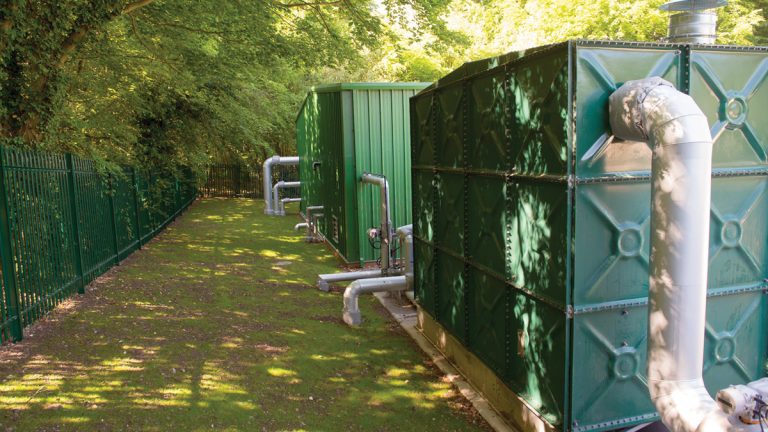
(foreground) Re-lift pumping suction tank (background) edge of MF building – Courtesy of South East Water/Ady Kerry
Undertakings
Following on from the successful Waterworks Road WTW it was decided to award both Stockbury and Kingston projects to the MNI Framework Contractor, BamNomenca (a Bam Nuttall/nmcn PLC – now Galliford Try – joint venture), via a separate Professional Service Contacts (PSC) and construction contracts (ECC) which enable a work flow continuity not only to the contractor but to many in the supply chain – membrane plant and motor control centres (MCC) suppliers as well as the mechanical and electrical installers. This move ensured that experience gained on the first MF project went into the remaining two, which in turn made the project delivery more efficient. For Kingston the opening PSC was awarded to BamNomenca in October 2015.
Innovations
This paved the way to identify three major areas where innovations could be made to make the project more efficient.
- The two proposed buildings to house the MF and the high lift pumps were to be combined into a single building.
- The means of disinfection was to be changed from hypochlorite dosing to duty/standby UV reactors which in turn avoided the need to demolish the disused contact tank and to construct a new one.
- Further efficiency was realised by redeveloping the disused contact tank into a series of tanks that was needed for the washwater recovery system as well as the neutralisation tank required for the chemical clean process.
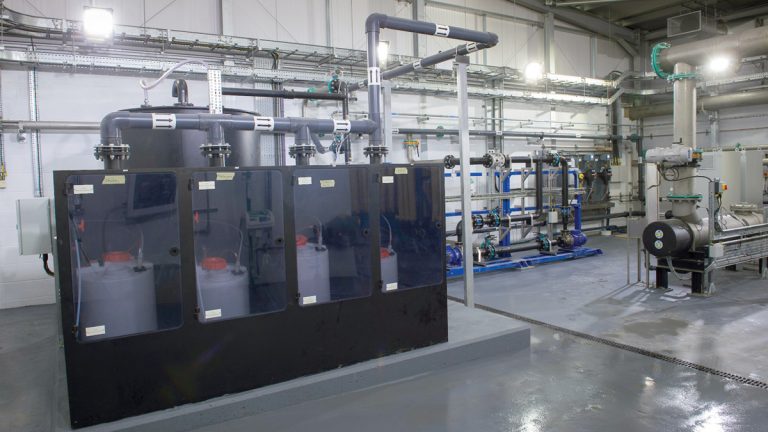
Clean-in-place chemical rig – Courtesy of South East Water/Ady Kerry
Public consultations
During this period a series of public consultation events were held and neighbours attended, which provided an opportunity to discuss the plans. It was important for the success of the project that any concerns expressed at these meetings were addressed. Concerns raised included any increase in noise levels, disrupted views (from back gardens) and the future of the orchids that were present and growing on the disused contact tank. The design was modified to ensure the noise generated from the new high lift pumps (which would be new features of the treatment works) would be contained within the building. Additional landscaping and planting would be deployed to enhance views from neighbouring properties.
It was agreed that the orchids would be transposed from their location and replanted in other areas of the site.
Construction
With these measures now in place a planning application was submitted in January 2016 and was successfully granted in March 2016. During this period the main elements of the design were completed and a construction contract, along with price, activity schedule and programme was issued and awarded to BamNomenca by mid-April 2016.
This was in conjunction with the construction of the MF plant at Stockbury being well underway and on programme by the same contracting team. The site team was mobilised to Kingston in May and the first on-site activity entailed transportation of the orchids.
Work then began on the construction of the 24m x14.8m x 5.75m high cladded building with a base founded on chalk in a 2.1 metres deep excavation, to enable sufficient bearing capacity for the foundations. With the foundation in place together with a retaining wall, the floor, structural steel work and cladding quickly followed and the whole structure was deemed water tight by the beginning of November just in time to take the first shipment of the MF equipment together with the MCC which was installed in quick succession. The race was then on to complete the mechanical and electrical installations inside the building before the Christmas break.
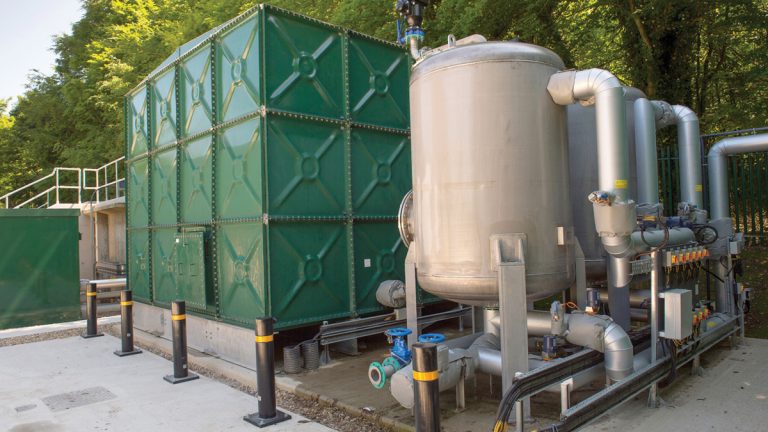
Part of washwater recovery system – Courtesy of South East Water/Ady Kerry
By Christmas, the below ground pipework across the site was laid along with a number of final connections that were made. In addition to this, the modifications made to the disused tank in order to create additional storage tanks required for the washwater recovery and chemical clean neutralisation systems. All this meant that the project was in a good position to enter the commissioning period on return in the New Year. Plans were then put in place for a series of site shutdowns to change two of the four borehole pumps.
On return in the New Year, it was critical to the programme that the washwater recovery system was completed and the relift storage tank required for the new high lift pumping station was delivered and installed by the end of January 2017. There was a slight delay in the delivery of the storage tanks however some expediting measures made by BamNomenca ensured that the tank was delivered on time.
Commissioning the plant
During this time, work to commission of the plant commenced including setting the air compressors required to operate the MF rack valves together with the dry testing of the MCC equipment.
With the new borehole pumps being of a lower head than the previous boreholes, a change in this borehole pump arrangement would mean that new high lift pumps would be needed to operate in order to maintain supplies. It was decided to change over two of the four borehole pumps, leaving two to bypass the MF plant to maintain supplies in the current process.
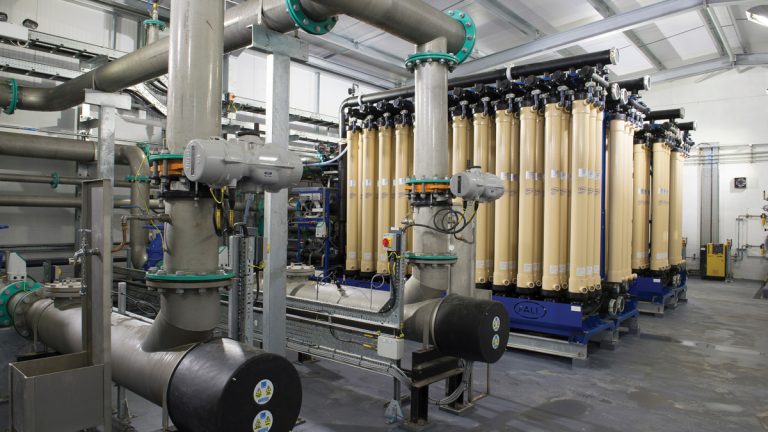
(Foreground) UV disinfection – (Background) MF racks – Courtesy of South East Water/Ady Kerry
This entire process commenced in January and lasted until the end of March 2017 with the final two borehole pumps changed towards the end of this period.
This enabled the new system to be fully commissioned, both statically and dynamically offline by-passing raw water from the relift tank around and through to the high lift pumps and back to the relift tank. As a result the system would be extensively tested in readiness for the switch over day.
With the site now ready, the final water quality testing and sampling was carried out and the system was deemed to be satisfactory to put into service. The chosen day was 26th March 2017 and a number of production technicians worked with BamNomenca commissioning engineers to swap over to the new system and complete a number of modifications required at the remainder of the treatment works including the existing water quality shutdown parameters.
With the DWI output date fast approaching and the nature of the changes being made on that date, everyone involved knew it was a day of ‘no going back’. This was a success and with the new plant in full operation and the two remaining existing borehole pumps being disabled, the DWI output was reached.



